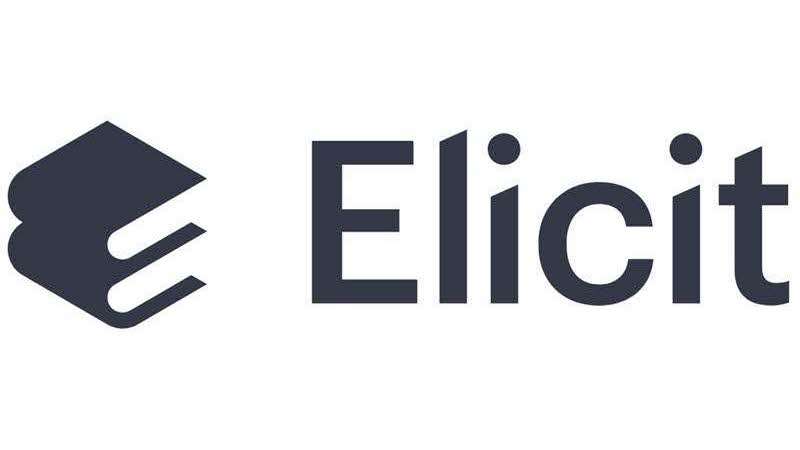If you’ve ever conducted a systematic literature review, you know firsthand what a massive undertaking it can be. On average, it takes a team of 5 researchers more than one year to go from start to publication. That’s countless hours spent combing through hundreds of dense academic papers, struggling to identify key findings and connect the dots between studies.
And after all that painstaking work, the end result is often far from perfect. One meta-analysis found that 25% of citations in medical journal articles contained substantive errors. Let that sink in – 1 in 4 references leading readers astray! Other research suggests that up to 80% of scientists don’t thoroughly read the papers they cite. Yikes.
A shortcut that could help you breeze through those piles of papers without sacrificing quality is Elicit AI.
Elicit won’t magically produce a publish-ready literature review in mere minutes. No AI tool can do that…yet. But as someone who’s spent countless late nights doing literature reviews, I can confidently say that Elicit is a gem for streamlining and enhancing this notoriously arduous process.
The power of semantic search
Before we dive into the nuts and bolts of using Elicit AI, let’s take a step back and understand what sets it apart from traditional literature search tools like Google Scholar. The key difference? Semantic search.
When you use a conventional search engine, you enter keywords, and the algorithm looks for exact matches in titles, abstracts, and full text. While this approach can find relevant papers, it has some limitations.
Semantic search, by contrast, uses AI-powered natural language processing to understand the meaning and context behind your search, not just the verbatim terms. When you ask Elicit a question, it analyzes the semantics to grasp what you’re really looking for, then scours its database for papers that best match that intent.
Let’s say you searched for papers on “the cognitive benefits of mindfulness meditation.” A keyword search might miss a highly relevant study that instead used the term “attentional improvements” because that synonym wasn’t in your original query. But Elicit’s semantic search would recognize the conceptual connection and surface that paper for you.
The power of semantic search really shines when you’re exploring complex, multifaceted topics. Imagine you’re investigating the link between social media use and adolescent well-being. A traditional search might return results skewed towards a single facet, like mental health. But with Elicit, you can craft a query that encompasses the full scope – something like “How does social media affect teenage mental health, social relationships, and academic performance?” – and get a comprehensive set of papers that cover all those angles.
Semantic search is a game-changer for literature reviews because it simulates what a human researcher does naturally – drawing insights based on the holistic meaning, not a rote pattern match of words. It connects concepts that might not overlap terminologically but are intimately related semantically.
So in a head-to-head comparison, Elicit’s semantic search consistently outperforms keyword-based searches on relevance, thoroughness, and efficiency. It’s like having an expert librarian who can intuit exactly what you need, even if you don’t give them the perfect set of keywords.
Of course, to get the most out of semantic search, it helps to understand a few best practices:
The rise of semantic search, powered by tools like Elicit, is a true inflexion point in how we conduct research. It’s not just about faster literature reviews – it’s about surfacing insights and connections that might have forever remained hidden in the old keyword-based paradigm. And that has the potential to accelerate the pace of discovery across every field of knowledge.
About Elicit AI
So what exactly is Elicit AI? In a nutshell, it’s an AI-powered research assistant that acts as your personal library assistant, helping you read and analyze massive troves of academic literature at superhuman speeds.
Under the hood, Elicit employs cutting-edge language models to comb through research papers, extract vital information, and serve up concise summaries highlighting the key takeaways. It’s like having a highly knowledgeable (and incredibly efficient) digital librarian in your pocket.
Elicit can access over 125 million papers! This isn’t just your average academic search engine. Rather than simply spitting back a list of links, Elicit actually reads and deeply analyzes the content, scouring full texts to unearth critical findings and conceptual connections that you’d likely miss with manual methods.
When I first started testing Elicit, I was blown away by how quickly it surfaced spot-on papers for my research questions. What would have normally taken me hours of trawling through Google Scholar, I accomplished in minutes with Elicit.
But make no mistake – Elicit isn’t trying to replace human researchers. It’s a sophisticated tool designed to enhance and accelerate your efforts, taking care of the time-consuming grunt work so you can focus on high-level analysis and insight generation. It won’t do your thinking for you, but it will serve up the raw materials you need to arrive at groundbreaking conclusions faster than ever before.
How to use Elicit AI
Ready to harness the power of Elicit for your own research? Here’s a step-by-step guide walking you through the key features and use cases:
Step 1: Create a free account
First things first, head over to Elicit.org and create your account. The generous free plan offers access to most core features, so you can dive right in and take it for a spin.

Step 2: Literature discovery and summary
This is one of Elicit’s strongest suits. Simply enter your research question, like “Does writing by hand lead to better retention than typing?” and watch the magic happen. Within seconds, Elicit will present a table of the most relevant papers, complete with one-sentence summaries highlighting their key findings.
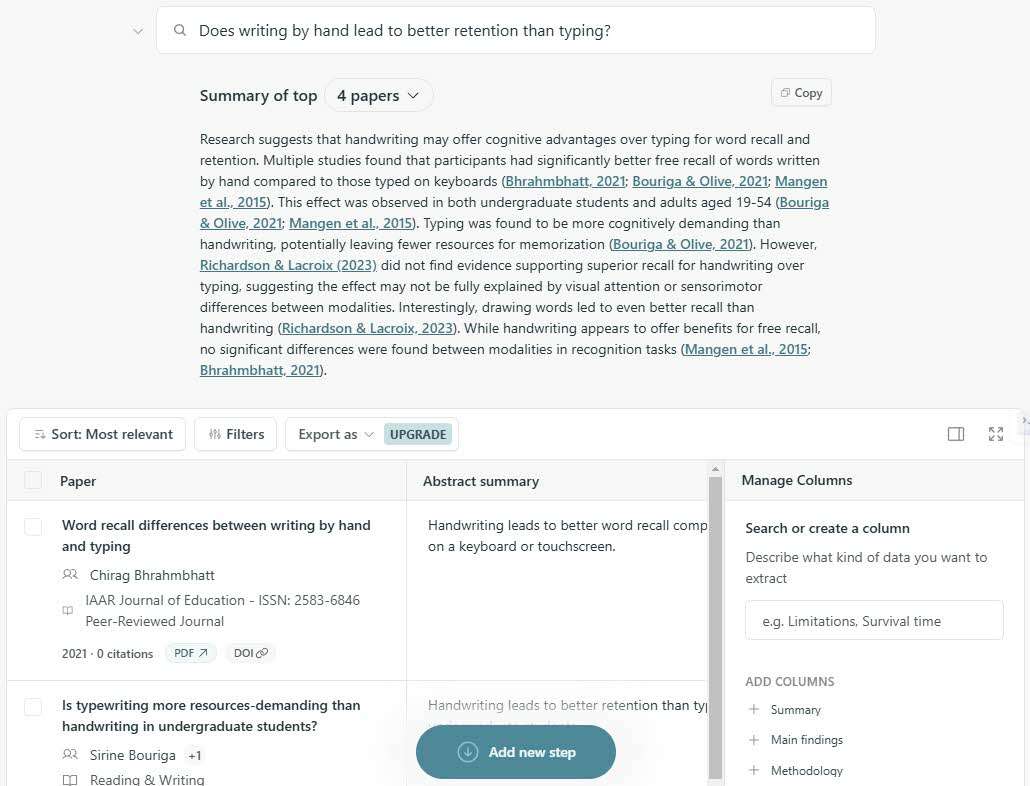
When I recently used this to explore the impact of note-taking on learning, Elicit surfaced a fantastic set of papers in under a minute. A search that would have previously taken me hours!
Step 3: Custom data extraction
Here’s where things get really exciting. Elicit allows you to extract specific data points from papers by adding custom columns to your results table. For instance, you could add a column to pull out sample sizes, effect sizes, or limitations noted by the authors.
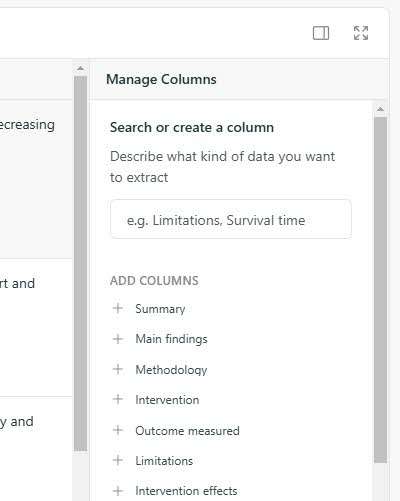
To do this, simply toggle the sidebar (if it’s not already showing), and either select from the preset options or input your own query, like “What were the key limitations of this study?”. You will then be able to enter custom instructions and options, before saving your column settings. Elicit will parse the full text of each paper and populate the new column with the relevant details.
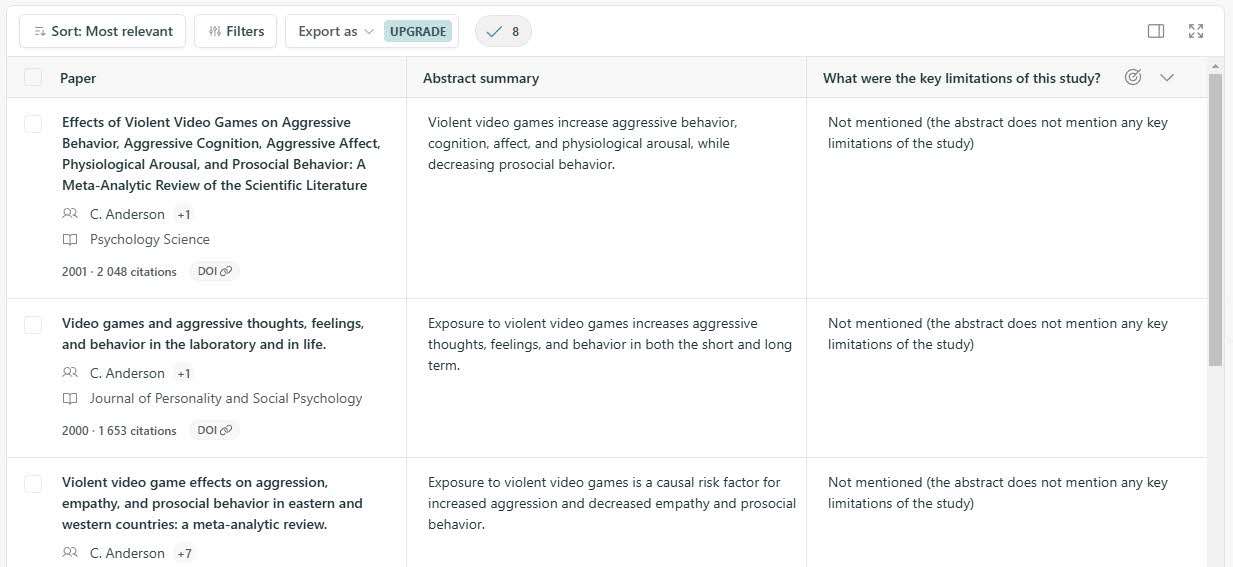
Step 4: Export your literature review
Once you’ve got your results table dialed in, you can export it to Excel with a single click. Boom, you’ve essentially got a Cliff’s Notes version of a full-fledged literature review!
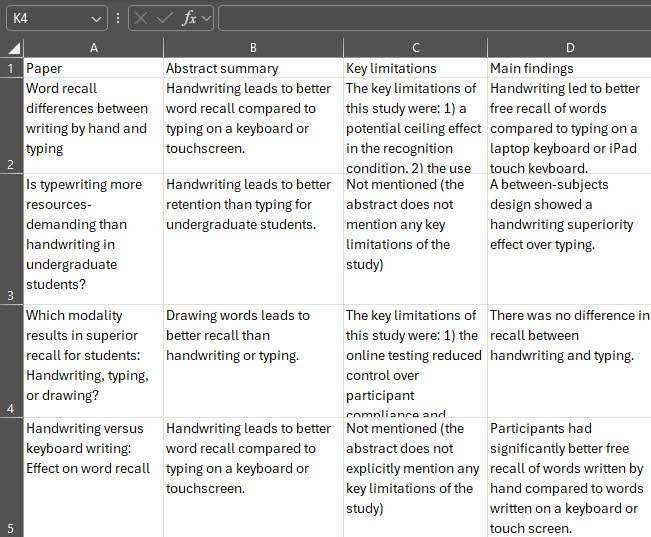
You’ll still need to analyze and synthesize the key takeaways yourself, but Elicit has taken care of the most laborious, time-consuming part of the process.
Step 5: Identify trends and research gaps
As you analyse your results table, keep an eye out for patterns, inconsistencies, or blind spots ripe for further investigation. Elicit can help you spot research gaps more efficiently by showing you how a topic has evolved over time.
For example, you might notice that most studies on a topic use narrow sample sizes. That’s a clear opportunity for a broader study! Or perhaps results become more consistent after a certain landmark paper. These are the kinds of research directions Elicit can reveal.
While Elicit’s interface is refreshingly user-friendly, there are still some limitations to keep in mind. It won’t catch every nuance a human would, so it’s important to verify key findings with your own careful reading. And of course, all AI systems can occasionally “hallucinate,” presenting false or misleading information. Elicit’s not immune to that.
But overall, if you approach it as a helpful assistant to enhance your research rather than a full-on replacement for human smarts, I think you’ll be absolutely thrilled with how much time and effort Elicit can save you. It’s become an indispensable part of my toolkit.
Benefits of Elicit AI
The single biggest advantage of Elicit is the massive amount of time it saves. When I say massive, I’m talking hours upon hours, in some cases even shaving days off of the typical literature review process.
By rapidly serving up the most relevant papers and providing those quick-hit one-sentence summaries, Elicit enables you to get a bird’s eye view of a research topic in record time. No more endless scrolling through search results, squinting at abstracts, and skimming introductions to determine if a paper is worth a full read.
With Elicit, I can breeze through dozens of papers in the time it used to take me to properly digest two or three. The one-sentence summaries are an absolute godsend, distilling the crux of a study into a highly skimmable snapshot that often tells me everything I need to know about whether to dive deeper.
And we can’t overlook the sheer power of the knowledge base that you’re able to tap into. 125 million papers! It’s an unfathomably large array of literature that even the most dedicated manual searches could never fully surface. The breadth of research you’re able to canvas with a single Elicit search might have taken weeks of combing through different databases in the past.
The data extraction capabilities are another huge plus, allowing you to pull out key details like sample sizes, effect sizes, and any limitations cited by the authors – all without cracking open the full PDF. Being able to assess factors like sample sizes at a glance provides a handy way to quickly evaluate the robustness and generalizability of a study’s findings.
You’ll still need to put in the intellectual labor of interpreting and synthesizing the patterns that emerge. Elicit’s not going to connect all the dots for you. But it drastically streamlines the process of gathering those dots in the first place!
Perhaps my favorite feature is the ability to export your results to an instant summary table ready for further analysis and write-up. What used to be the final, painstaking step of a traditional literature review now happens dynamically as you go.
You’ll still need to carefully vet the details surfaced by Elicit and read the full text of the most vital papers. No AI can (yet) match human wisdom and critical thinking skills. But as a power-up for your research workflow, allowing you to cover exponentially more ground in a fraction of the time? Elicit is tough to beat.
Drawbacks of Elicit AI
As much as I love Elicit, I wouldn’t be doing my due diligence if I didn’t point out a few limitations and areas for improvement. Let’s start with the big one – the need for human verification.
While Elicit’s AI-powered summaries and data extractions are impressively accurate, they’re not infallible. There have been instances where the one-sentence summary missed a key caveat, or where the extracted sample size didn’t match what was reported in the full text. These mistakes are rare, but they do happen.
That’s why it’s critical to use Elicit as a starting point for exploration and discovery, but not to blindly trust every detail without verification. You’ll still need to dive into the full papers, particularly for any findings you intend to emphasize in your own work, to ensure nothing gets lost in translation.
Another limitation to consider is that some of Elicit’s most powerful features, like the ability to add multiple custom data extraction columns, are capped in the free plan. Avid researchers will likely want to upgrade to unlock the full potential.
It’s also worth noting that Elicit seems to work best for topics that are well-represented in mainstream academic literature. If you’re researching a highly niche or cutting-edge subfield, you may find Elicit’s knowledge base somewhat limited.
Like any AI system, Elicit can also occasionally “hallucinate,” presenting erroneous or nonsensical information. These glitches are uncommon and usually easy to spot, but they’re a good reminder of why human oversight remains essential.
Lastly, and this is more of an aspirational note than a true con, Elicit can’t match the nuanced analysis and synthesis that an expert human brings to a literature review. It can surface relevant information with incredible speed and efficiency, but weaving those threads into an original narrative is still up to you.
So while Elicit drastically accelerates the research process and uncovers valuable insights you might have otherwise missed, it’s not a magic wand that eliminates the need for human wisdom and critical thinking. It’s a powerful tool to be wielded by discerning researchers – not a replacement for expertise.
Bottom line
So here’s the deal – if you’re a researcher who’s ever felt bogged down by the sheer volume of literature you need to stay on top of, Elicit AI is absolutely worth adding to your toolkit. Yes, it has some limitations, but in my experience, the benefits massively outweigh the drawbacks.
There is a bit of a learning curve, as with any powerful new tool. But it only took me a few hours of playing around to really hit my stride with Elicit and incorporate it smoothly into my workflow. Once I did, it completely changed my research process.
On a recent project Elicit helped me canvas an enormous body of literature in a fraction of the time it would have normally taken. I was able to rapidly identify key studies, extract vital data points, and surface groundbreaking older papers I would have likely never found on my own.
Did I still have to put in the hours carefully poring over the most relevant papers and critically analyzing the patterns that emerged? Absolutely. Elicit isn’t a magic bullet that can replace human insight and rigor. But Elicit streamlined my literature review process by an order of magnitude. It cut through the noise, pointed me in the right direction, and uncovered hidden gems I might have otherwise missed.
It’s like having a brilliant and highly efficient research assistant who does all the grunt work of scanning and summarizing, freeing me up to focus on the high-level analysis and synthesis.
So if you’re a researcher who’s feeling the strain of information overload, I highly recommend giving Elicit a shot. Be prepared to be blown away by how much easier and more efficient the literature review process can be with this AI powerhouse in your corner.
